17 Birds with a Red Head in North America (with Pictures)
Last Updated on
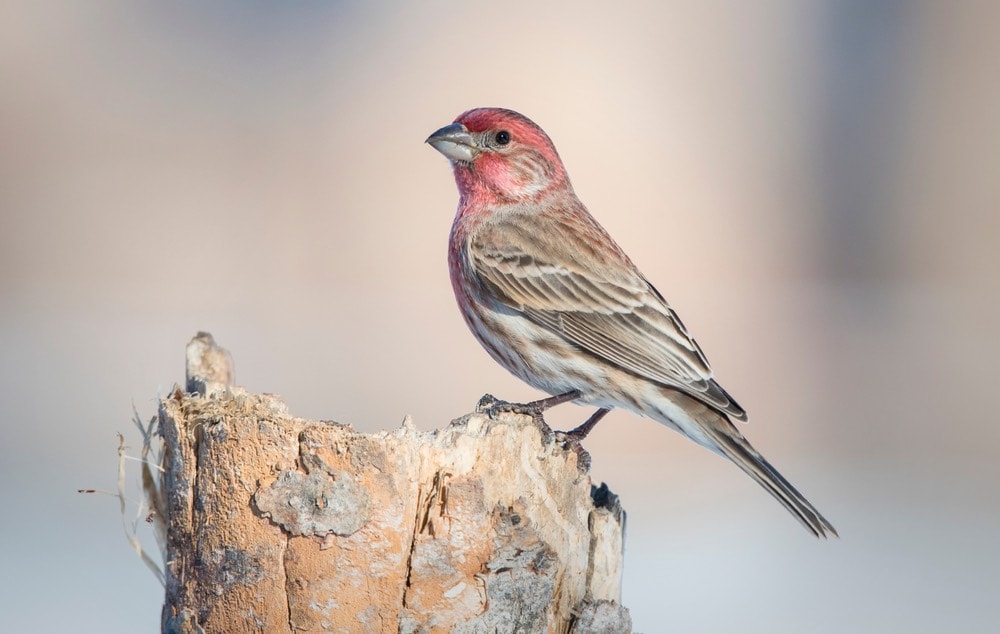
North America is a great place for budding birdwatchers to spot red-headed birds!
Some species have only a hint of red on their head, while others sport a flamboyant red crown. Take note that the following list does not include all the birds with red on the head, but especially those that you are likely to see in your garden or during your hikes.

The 17 Birds with a Red Head in North America
1. Northern Cardinal
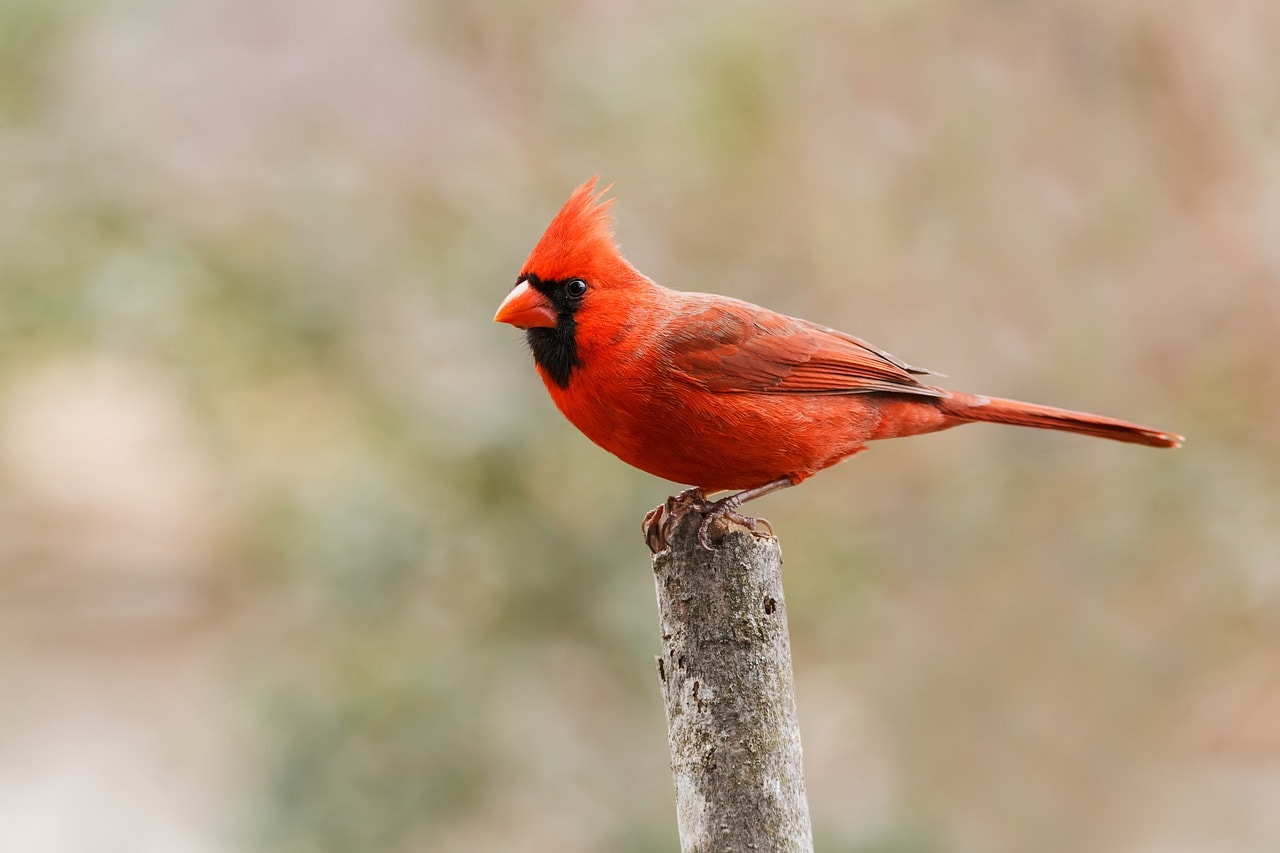
The Northern Cardinal (Cardinalis cardinalis) owes its name to the vibrant red color of the plumage of the male, reminiscent of the red clothing of cardinals. It is a beautiful medium-sized bird, easily recognizable by its crest and its black facial mask (in the male). In addition, this species shows marked sexual dimorphism: the male is bright red while the female is dull reddish-brown. The Northern Cardinal feeds mainly on seeds but will not mind a few insects and fruits on occasion. This bird is extremely territorial and goes so far as to fight against its own reflection if it sees itself in a mirror or window!
It is present in southern Canada, in the eastern United States (from Maine to Texas), in Mexico, and in Northern Guatemala and Belize. It frequents woods, gardens, and marshes.
2. House Finch
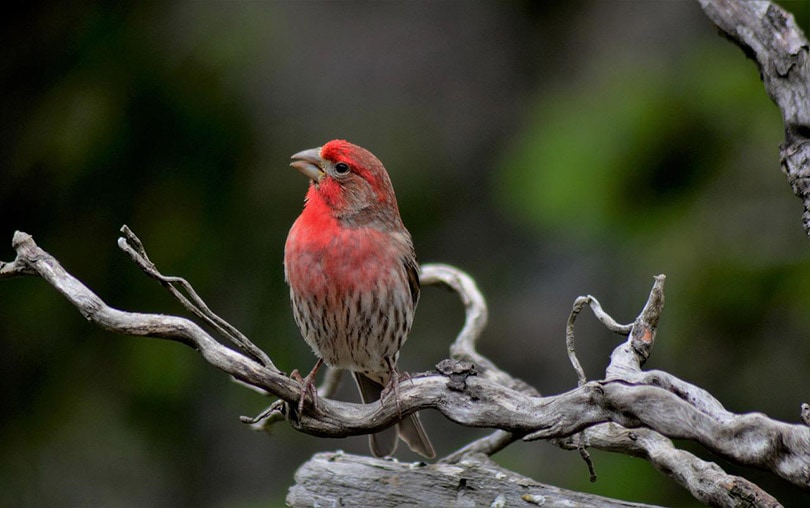
The House Finch (Haemorhous mexicanus) is a very common small passerine bird that can be seen throughout North America. The size of a sparrow, it has a strong beak due to its predominantly seed-eating diet. The male’s head, throat, and chest are almost entirely red. Its back is brownish with a red rump, and its belly is pale striped with brownish bands. The female is rather gray with a pale streaked breast and darker wings with two discreet white bands.
Very friendly, this little bird happily frequents feeders and nest boxes made available by bird lovers, but can also cause damage in orchards. This species lives mainly in the suburbs near dwellings.
3. Downy Woodpecker
https://www.instagram.com/p/CbLFE2erScv/
The Downy Woodpecker (Picoides pubescens) is the most common woodpecker in eastern North America. This small woodpecker is black and white and has a broad white stripe down the middle of the back, extending from the shoulders to the rump. The male has a small scarlet spot, like a red pompom, on the back of the crown. Black and white checks are outlined under the wings and the breast and flanks are white. The crown is black, while the cheeks and neck are marked with black and white lines.
4. Red-Bellied Woodpecker
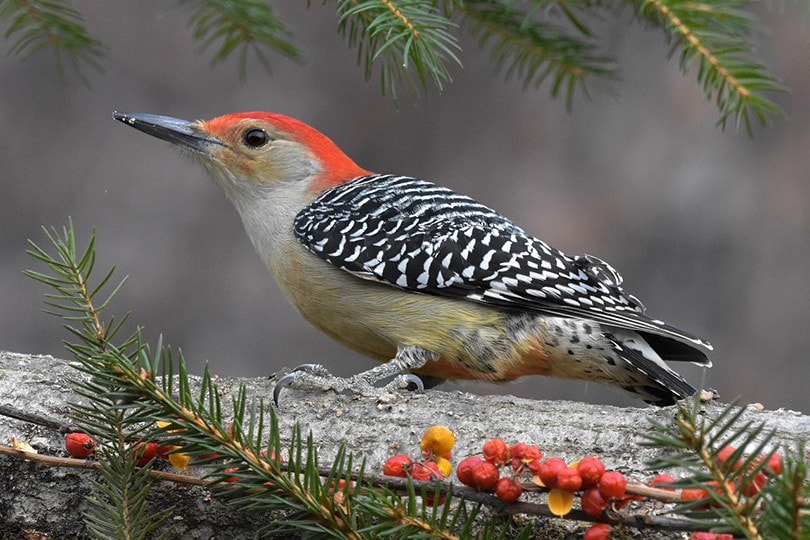
The Red-Bellied Woodpecker (Melanerpes carolinus) bears its name rather badly because it is very rare that we can see the little pronounced red tint of its belly! It is better to try to differentiate it with its black and white bars on the back and wings, its beige chest and face, and its red nape, which extends to the crown in the male. The female has a red nape like the male, but her crown is gray rather than red. The Red-Bellied Woodpecker can be observed in forested and suburban areas where it generally prefers deciduous trees. Moreover, if you want to attract it to your feeders, leave a little suet, it will come back for more!
5. Barn Swallow

The Barn Swallow (Hirundo rustica) is a small, migratory passerine species living in Europe, Asia, Africa, and America. It is distinguished by its long, forked tail and its brick-red throat. It nests in an ingenious nest made of dried earth and saliva to glue the pieces of earth, hung under a roof, a beam, both outside and inside, in town or in the country, often in barns and even sometimes in houses. It feeds mainly on insects caught in flight.
6. Hairy Woodpecker

The Hairy Woodpecker (Picoides villosus) frequents forest edges, swamps, pine, oak, birch forests, or orchards. They are particularly fond of places where dead trees are still standing. It can also be found on the outskirts of cities, in parks, and in residential areas. Their habitat ranges from sea level up to 2,000 meters above sea level.
The middle of the back and underside, from throat to tail, are white. The head is black and white striped with a red spot for the male, and the beak is long and with hairs (vibrissae) at the base. The white feathers under the tail have no black point. In addition, the Hairy Woodpecker can be differentiated from the Downy Woodpecker by its larger size, its long beak, and the white feathers under the tail which do not have a black point.
Both sexes are similar, except for the red spot behind the head, exclusive to the male.
7. Pileated Woodpecker
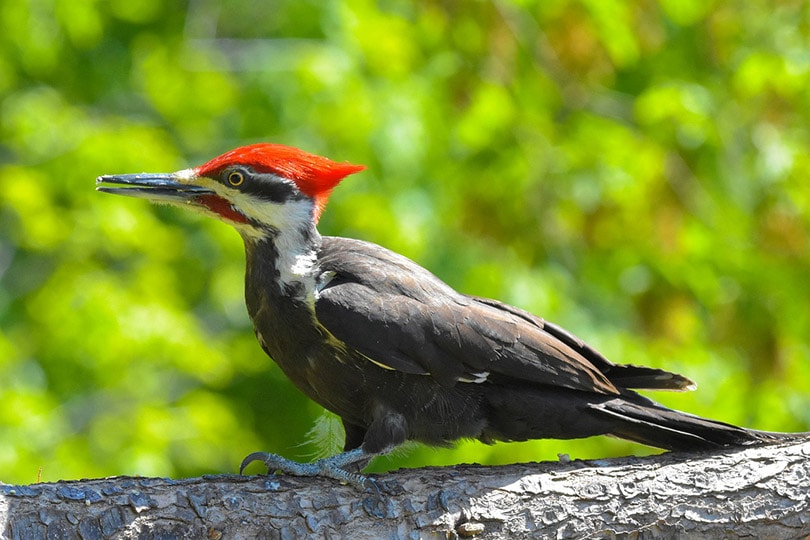
The Pileated Woodpecker (Dryocopus pileatus) is a large bird with mainly black plumage. The male is characterized by his superb red crest and a white line running down the sides of the neck.
This sedentary bird lives in forests with tall trees in Canada, in the east, and on part of the Pacific coast of the United States. It usually digs large nests in the trunks of dead trees and usually makes a new nest each year, leaving the previous one free.
8. Anna’s Hummingbird
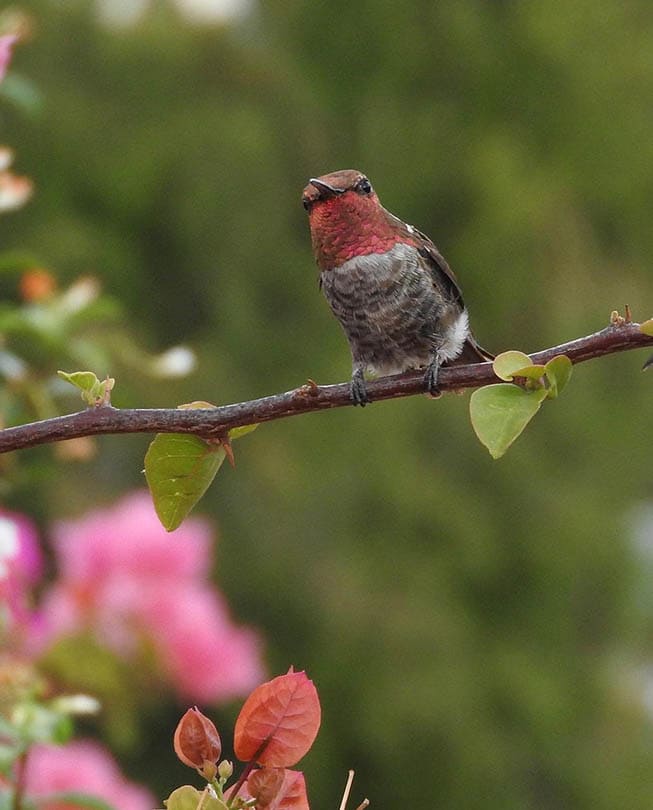
The lovely Anna’s Hummingbird (Calypte anna) measures barely 10 cm in length. It is easily recognizable by its bronze-green back, paste-grey chest, and green belly. The male sports a magnificent crown of an iridescent crimson red with a slightly forked black tail. It is also the only species of hummingbird in North America with a red crown. Females have a green crown and a grayish belly. These tiny and adorable birds feed on the nectar of flowers with their long, extendable tongues, which help in the pollination of plants.
9. Acorn Woodpecker

The Acorn Woodpecker (Melanerpes formicivorus) has mostly black and white plumage except for a red crown. The underside of the body is white striped with black. This bird feeds on acorns, fruits, and insects. It makes reserves in the crevices of trees and in the cavities, it digs there.
This species, as its name suggests, relies heavily on acorns as its primary food source. Acorns are such an important resource for woodpecker populations that live in California that acorn woodpeckers may nest in the fall to take advantage of acorn harvesting, which is a fairly rare behavior among birds.
10. Pine Grosbeak

The Pine Grosbeak (Pinicola enucleator) is a magnificent, plump bird with a redhead and gray eye contours. Its back is brown and streaked with grey, red, black, and white. Its large thick beak is brown marked with black at its end. The female has a greenish-yellow plumage. These birds are found from Alaska to the Northwestern United States.
11. Scarlet Tanager
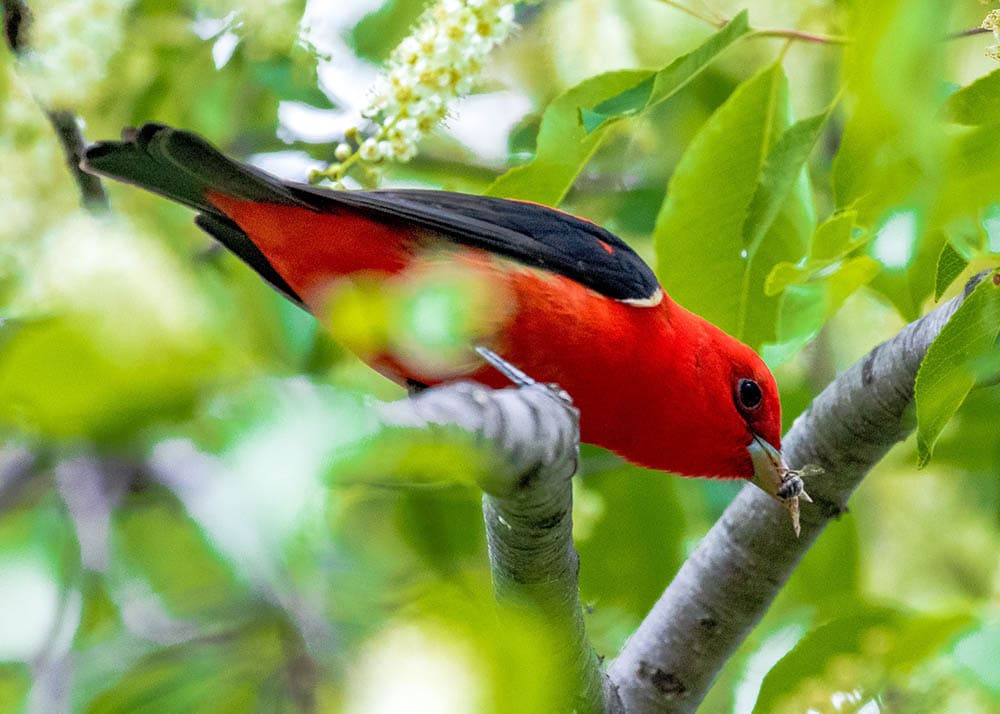
Scarlet Tanager (Piranga olivacea) is a species of bird in the Cardinalidae family. It is easily recognizable thanks to its bright red plumage tending to orange, and its brownish wings. This species breeds in mature deciduous forests, sometimes in mixed or pine forests. It can live in wooded parks and tall trees in residential areas. In winter, it lives on top of trees, in evergreen mountain forests.
12. Red-headed Woodpecker
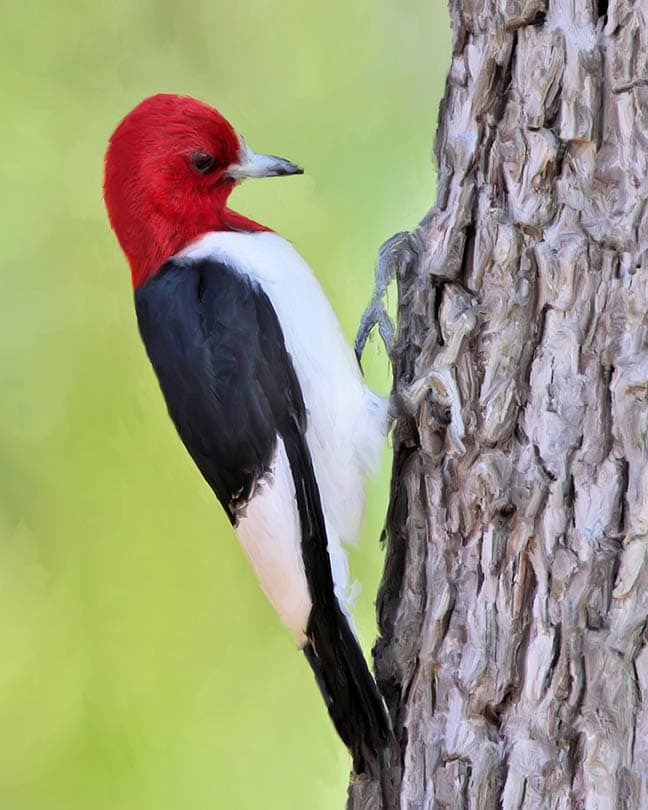
The Red-headed Woodpecker (Melanerpes erythrocephalus) is about 8 inches long. This bird is easily recognized by the striking red coloring of its head, neck, throat, and upper breast, which contrasts with the white underparts and black upper parts of its body. Large white patches, formed by the secondary feathers and the inner tertial feathers, are visible on the wings. Moreover, the male and the female are similar. This species is found only in North America.
13. Redhead

The Redhead (Aythya americana) is a well-known and widespread diving duck in North America. The adult male is a large, gray-backed, white-breasted duck with a brownish-rufous head and a black neck and throat. It resembles the male Canvasback which is larger than it. Seen up close, the head appears to be swollen, the forehead abruptly raised, and the beak broad and short, unlike the Canvasback which has a longer beak and receding forehead. The adult female is a large duck with a brown back, white breast, brown head, whitish chin, abruptly raised forehead, short, broad beak, and mottled pearl-grey wings. Although larger, it can easily be confused with the female Ring-necked Duck, as well as the Greater Scaup and Lesser Scaup.
14. Summer Tanager
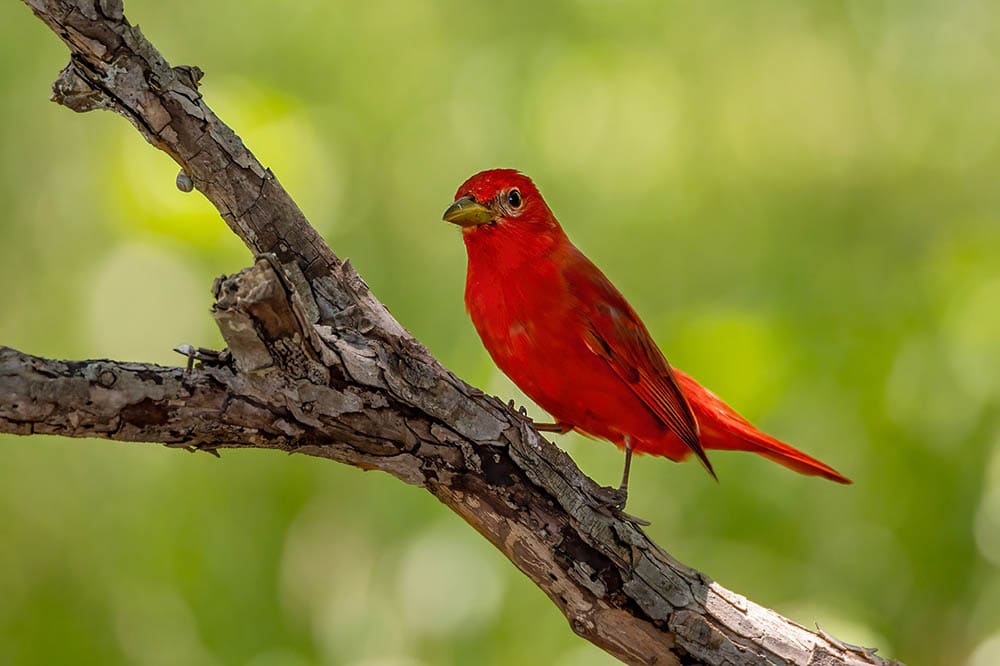
The Summer Tanager (Piranga rubra) is a flamboyant bird with its fiery red plumage, perfect for any bird named “summer”. Part of the family Cardinalidae but formerly and occasionally still classified in the bird family Thraupidae, they are bold and showy birds that are however shyer than their stunning color suggests.
15. Vermilion Flycatcher
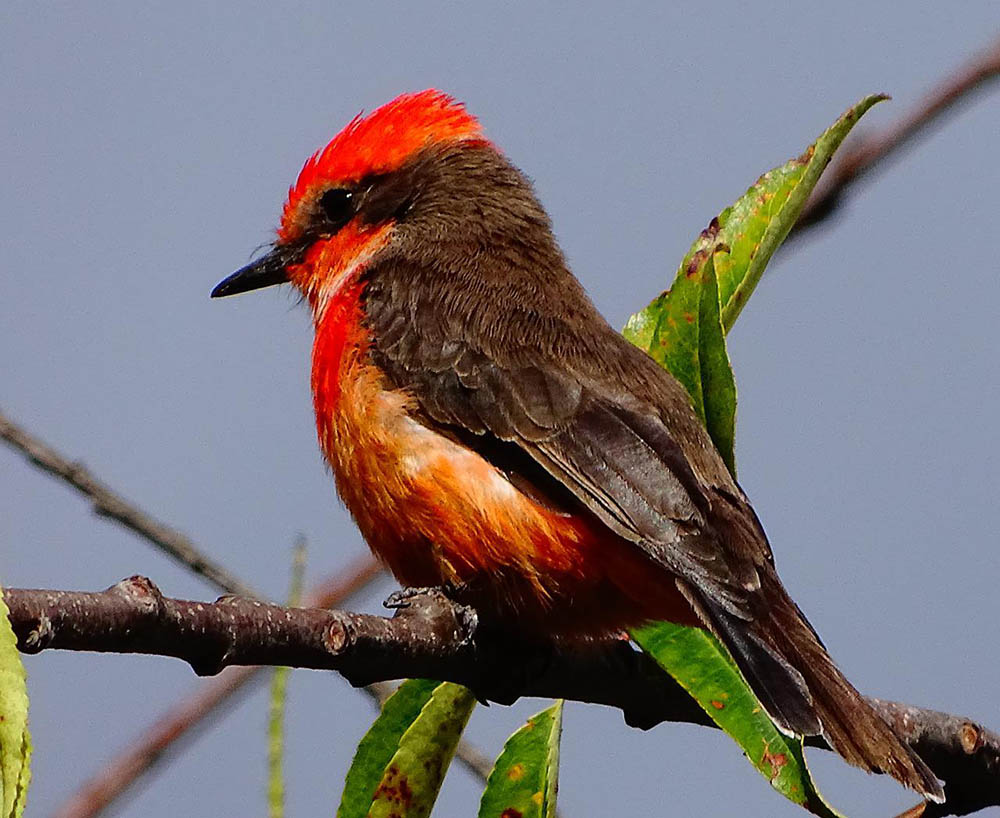
Vermilion Flycatcher (Pyrocephalus obscurus) is a small passerine bird found throughout South and Central America. Most flycatchers have rather dull plumage, but the vermilion flycatcher is a notable exception, with its vibrant orange-red belly and crown.
16. Red Crossbill

The Red Crossbill (Loxia curvirostra) has a very particular beak that gave it its name. Its crossed beak has two mandibles which allow it to extract seeds more easily. Most of its body is red except for its wings and black tail. In addition, the Red Crossbill is the typical bird of coniferous forests; it is found in Northern Europe, Asia, and North America. It is the most common and widespread of the crossbills.
17. Cassin’s Finch

The Cassin’s Finch (Haemorhous cassinii) is a small, stocky bird with a red crown, pale striped sides, and a pink breast. The female has a greenish plumage and has fine stripes on the sides. This species inhabits the mountainous regions of North America and prefers to nest in mature conifers.

Final Thoughts
This completes our list of the main species of red-headed birds found mainly in North America, although some do not hesitate to migrate south when the harsh winter sets in. We hope this will help you identify these magnificent specimens of birds more easily if you are lucky enough to spot them on your hikes!
Featured Image Credit By: Jeff Caverly, Shutterstock
Table of Contents
- The 17 Birds with a Red Head in North America
- 1. Northern Cardinal
- 2. House Finch
- 3. Downy Woodpecker
- 4. Red-Bellied Woodpecker
- 5. Barn Swallow
- 6. Hairy Woodpecker
- 7. Pileated Woodpecker
- 8. Anna’s Hummingbird
- 9. Acorn Woodpecker
- 10. Pine Grosbeak
- 11. Scarlet Tanager
- 12. Red-headed Woodpecker
- 13. Redhead
- 14. Summer Tanager
- 15. Vermilion Flycatcher
- 16. Red Crossbill
- 17. Cassin’s Finch
- Final Thoughts
About the Author Genevieve Dugal
Genevieve is a biologist and science writer and has a deep love for capuchin monkeys, pumas, and kangaroos, which has taken her around the world to work and volunteer for several wildlife rehabilitation centers. A Canadian expat, Genevieve now lives in Argentina, where she wakes up every morning to horses and cows saying hello from the vast plain next to her home office window. Having the privilege of sharing her knowledge and passion for animals of all kinds is what makes her fulfilled and happy.
Related Articles:
Monocular vs Telescope: Differences Explained (With Pictures)
10 Types of Hummingbirds in Arkansas (With Pictures)
8 Types of Hummingbirds in Nebraska (With Pictures)
5 Types of Hummingbirds in Idaho (With Pictures)
3 Types of Hummingbirds in Mississippi (With Pictures)
8 Types of Hummingbirds in Kansas (With Pictures)
5 Types of Hummingbirds in West Virginia (With Pictures)
5 Types of Hummingbirds in Ohio (With Pictures)
